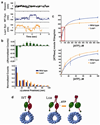A cytoplasmic dynein tail mutation impairs motor processivity
- PMID: 21102439
- PMCID: PMC3385513
- DOI: 10.1038/ncb2127
A cytoplasmic dynein tail mutation impairs motor processivity
Abstract
Mutations in the tail of the cytoplasmic dynein molecule have been reported to cause neurodegenerative disease in mice. The mutant mouse strain Legs at odd angles (Loa) has impaired retrograde axonal transport, but the molecular deficiencies in the mutant dynein molecule, and how they contribute to neurodegeneration, are unknown. To address these questions, we purified dynein from wild-type mice and the Legs at odd angles mutant mice. Using biochemical, single-molecule, and live-cell-imaging techniques, we find a marked inhibition of motor run-length in vitro and in vivo, and significantly altered motor domain coordination in the dynein from mutant mice. These results suggest a potential role for the dynein tail in motor function, and provide direct evidence for a link between single-motor processivity and disease.
Figures





Comment in
-
Dynein at odd angles?Nat Cell Biol. 2010 Dec;12(12):1126-8. doi: 10.1038/ncb1210-1126. Epub 2010 Nov 21. Nat Cell Biol. 2010. PMID: 21102436
Similar articles
-
Neurodegenerative mutation in cytoplasmic dynein alters its organization and dynein-dynactin and dynein-kinesin interactions.J Biol Chem. 2010 Dec 17;285(51):39922-34. doi: 10.1074/jbc.M110.178087. Epub 2010 Oct 2. J Biol Chem. 2010. PMID: 20889981 Free PMC article.
-
Neuromuscular junction defects in mice with mutation of dynein heavy chain 1.PLoS One. 2011 Feb 4;6(2):e16753. doi: 10.1371/journal.pone.0016753. PLoS One. 2011. PMID: 21346813 Free PMC article.
-
Cytoplasmic dynein heavy chain: the servant of many masters.Trends Neurosci. 2013 Nov;36(11):641-51. doi: 10.1016/j.tins.2013.08.001. Epub 2013 Sep 10. Trends Neurosci. 2013. PMID: 24035135 Free PMC article. Review.
-
Neuronal migration defects in the Loa dynein mutant mouse.Neural Dev. 2011 May 25;6:26. doi: 10.1186/1749-8104-6-26. Neural Dev. 2011. PMID: 21612657 Free PMC article.
-
Defective axonal transport in motor neuron disease.J Neurosci Res. 2007 Sep;85(12):2557-66. doi: 10.1002/jnr.21188. J Neurosci Res. 2007. PMID: 17265455 Review.
Cited by
-
Quantitative Determination of the Probability of Multiple-Motor Transport in Bead-Based Assays.Biophys J. 2016 Jun 21;110(12):2720-2728. doi: 10.1016/j.bpj.2016.05.015. Biophys J. 2016. PMID: 27332130 Free PMC article.
-
Cytoplasmic dynein moves through uncoordinated stepping of the AAA+ ring domains.Science. 2012 Jan 13;335(6065):221-5. doi: 10.1126/science.1215804. Epub 2011 Dec 8. Science. 2012. PMID: 22157083 Free PMC article.
-
Load-dependent detachment kinetics plays a key role in bidirectional cargo transport by kinesin and dynein.Traffic. 2019 Apr;20(4):284-294. doi: 10.1111/tra.12639. Traffic. 2019. PMID: 30809891 Free PMC article.
-
The axonal transport motor kinesin-2 navigates microtubule obstacles via protofilament switching.Traffic. 2017 May;18(5):304-314. doi: 10.1111/tra.12478. Epub 2017 Apr 5. Traffic. 2017. PMID: 28267259 Free PMC article.
-
Impact-Free Measurement of Microtubule Rotations on Kinesin and Cytoplasmic-Dynein Coated Surfaces.PLoS One. 2015 Sep 14;10(9):e0136920. doi: 10.1371/journal.pone.0136920. eCollection 2015. PLoS One. 2015. PMID: 26368807 Free PMC article.
References
-
- Paschal BM, Vallee RB. Retrograde transport by the microtubule associated protein MAP 1C. Nature. 1987;330:181–183. - PubMed
-
- Hafezparast M, et al. Mutations in dynein link motor neuron degeneration to defects in retrograde transport. Science. 2003;300:808–812. - PubMed
-
- Puls I, et al. Mutant dynactin in motor neuron disease. Nat Genet. 2003;33:455–456. - PubMed
Publication types
MeSH terms
Substances
Grants and funding
LinkOut - more resources
Full Text Sources

